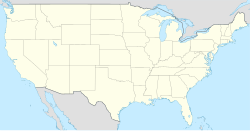Olympic National Park
| Olympic National Park | |
|---|---|
 Kort over Olympic National Park | |
| Ligger i | USA |
| Område | Washington |
| Nærmeste by | Port Angeles, Clallam County |
| Areal | 3.733 km² |
| Oprettet | 29. juni 1938 |
| Årligt besøgstal | 2.749.197 (2006) |
| Oversigtskort | |
47°58′N 123°30′V / 47.97°N 123.50°VKoordinater: 47°58′N 123°30′V / 47.97°N 123.50°V | |
Olympic National Park er en nationalpark, et biosfærereservat og et verdensarvsområde på Olympic halvøen i delstaten Washington i USA. Parken blev etableret 29. juni 1938, og er på 3.733 km². De vigtigste naturattraktioner i parken er uberørt natur i tre meget forskellige biotoper: Stillehavskystlinjen, Olympic Mountains og den tempererede regnskov.
Historie
Præsident Theodore Roosevelt udformede Olympic National Monument i 1909, primært for at beskytte den tilbageværende stamme af wapiti-underarten Cervus canadensis roosevelti, også kendt som Roosevelt Elgen. Området fik nationalparkstatus i 1938. I 1976 blev parken et internationalt biosfærereservat og i 1981 kom den på verdensarvslisten. I 1988 fik 95% af arealet i parken en forstærket beskyttelse som Olympic Wilderness under Washington Park Wilderness Act [1].
Naturen og landskabet
Den indre, og absolut største del af nationalparken, udgøres af Olympic Mountains. De højeste tinder er Mount Olympus (2.428 moh.) og Mount Deception (2.374 moh.). På trods af den relativt lave højde, bevirker lokale klimaforhold, at større dele af bjergene er så kolde at de ligger over trægrænsen. Nogle tinder er under permanent snedække og Olympic Mountains rummer mange små gletsjere, dog kun fire som er større end 1 km².
Den vestlige del af fredningen, ligger i det vådeste område i hele det kontinentale USA og fra bjergene er der mod vest udsigt til tempererede regnskove, herunder Hoh og Quinault. Her er meget mose og floraen domineres af store nåletræer, mos og bregner, alt sammen næret af de store regnmængder fra Stillehavet.
Løsrevet fra den indre del af nationalparken, ligger 117 km kystlinje langs Stillehavet. Dette område er ubeboet, med undtagelse af to stammesamfund ved hvert sit flodudløb.
Dyre- og plantelivet i området har flere endemiske arter, på grund af bjergenes afgrænsende forløb, f.eks. murmeldyret Marmota olympus.
Galleri
- Natur og landskaber
Rivende floder (Elwha River)
- Dyr
- (c) sandyriverfisher, CC BY-SA 3.0
Sorthalet hjort
Sodfarvet Hjerpe
Chumlaks, også kendt som Hundelaks, fylder floderne i gydeperioden. De er en mindre farvestrålende underart af Stillehavslaksen.
- Planter
Se også
Referencer
Eksterne henvisninger
- Officielt websted
- Om Olympic National Park på UNESCOs websted
|
Medier brugt på denne side
A 1×1 transparent image. Useful for when a template requires an image but you don't have one.
Forfatter/Opretter: Tom Harpel from Seattle, Washington, United States, Licens: CC BY 2.0
Lake Quinault
Forfatter/Opretter: John Rusk from Berkeley, CA, United States of America, Licens: CC BY 2.0
Acer circinatum—vine maple. Fall comes early to the garden's vine maples, the North American species most closely related to Palmatum group of East Asian Maples, especially A. japonicum (Fullmoon Maple) and A. pseudosieboldianum (Korean Maple). The leaves start to turn in August, sometimes even earlier. Photographed at Regional Parks Botanic Garden located in Tilden Regional Park near Berkeley, CA.
Forfatter/Opretter: Walter Siegmund (talk), Licens: CC BY-SA 3.0
Sooty Grouse male
Logo of the United States National Park Service, an agency of the United States Department of the Interior. This version is shaded to look as if it has been carved out of wood or rock. The elements on the logo represent the major facets of the national park system. The Sequoia tree and bison represent vegetation and wildlife, the mountains and water represent scenic and recreational values, and the arrowhead represents historical and archeological values. The bison is also the symbol of the Department of the Interior. The logo became the official logo on July 20, 1951, replacing the previous emblem of a Sequoia cone, and has been used ever since. The design was slightly updated in 2001, and a few different renderings are used today. For more information, see here and here.[dead link]
Threatened Hood Canal chum salmon running up Big Quilcene River in the Olympic National Forest
(c) sandyriverfisher, CC BY-SA 3.0
Blacktail doe at Hurricane ridge
Forfatter/Opretter: Ron Clausen, Licens: CC BY-SA 4.0
Elk Mountain in Olympic National Park seen from Obstruction Peak
Forfatter/Opretter: WolfmanSF, Licens: CC BY-SA 3.0
View of bigleaf maples (Acer macrophyllum) covered with epiphytic spikemoss (Selaginella oregana) and licorice ferns (Polypodium glycyrrhiza) in the Hoh Rainforest, Olympic National Park, Washington, USA. A nurse log lies on the forest floor on the left.
Forfatter/Opretter: Scott Costello from White Bear Lake, MN, USA, Licens: CC BY 2.0
The Olympic Marmot is the Pacific Northwest cousin of Eastern Marmot that is commonly known as a groundhog or woodchuck.
Warrior Peak seen from Home Lake in Olympic National Park
Forfatter/Opretter: abdallahh from Montréal, Canada, Licens: CC BY 2.0
Thuja plicata, Vancouver, BC, Canada.
Map of Olympic National Park
Forfatter/Opretter: Adbar, Licens: CC BY-SA 3.0
Nikon 1 V1 + 1 Nikkor VR 10-30mm f/3.5-5.6
Forfatter/Opretter: Leslie Seaton from Seattle, WA, USA, Licens: CC BY 2.0
Band-tailed Pigeon Patagioenas fasciata perched in a Bigleaf Maple Acer macrophyllum
Forfatter/Opretter: Doug Kerr from Albany, NY, United States, Licens: CC BY-SA 2.0
Hoh Rainforest - Olympic National Park - Washington State
Bald eagle (Haliaeetus leucocephalus) in Olympic National Forest in September
Forfatter/Opretter: Dave Powell, USDA Forest Service, Licens: CC BY 3.0 us
Populus trichocarpa mature tree in mixed forest. Lookingglass Creek, Walla Walla Ranger District, Umatilla National Forest, northeastern Oregon.
Forfatter/Opretter: rachel_thecat, Licens: CC BY-SA 2.0
The Kalaloch Cedar, just off Highway 101 in the Olympic National Park, with a dbh of 599 (19,6 ft) cm and wood volume of 350 cubic meters (12,270 cu ft) (Van Pelt 2001). (From http://www.conifers.org/cu/th/plicata.htm (Archive.org) (Working URL, 2024))
Best Large On BlackOld-growth Douglas-fir forest in the Bull Run watershed, Mount Hood National Forest, Oregon.
Forfatter/Opretter: KimonBerlin, Licens: CC BY-SA 2.0
Quinault Rainforest
Forfatter/Opretter: Ron Clausen, Licens: CC BY-SA 4.0
Mount Angeles seen from Eagle Point on Hurricane Ridge. Olympic National Park, Washington state.
Forfatter/Opretter: NordNordWest, Licens: CC BY-SA 3.0
Location map of the United States ("lower 48")
Forfatter/Opretter: Matthew Zalewski, Licens: CC BY-SA 3.0
A Roosevelt Elk in the Wild during Mating Season in Western Washington.
Forfatter/Opretter: Farwestern Photo by Gregg M. Erickson, Licens: CC BY 3.0
180° panorama from Ruby Beach, Olympic National Park, late in the afternoon of a Sunny September afternoon. Photo by Gregg M. Erickson






















































